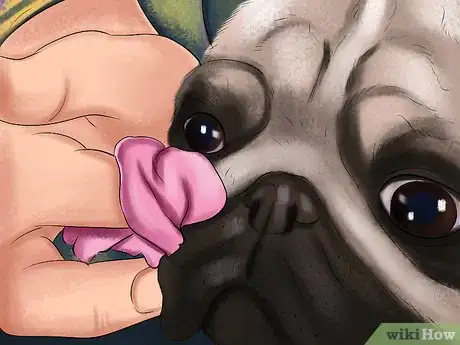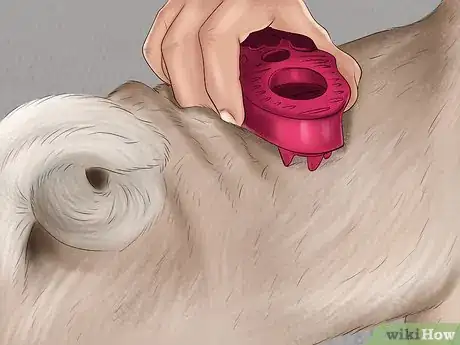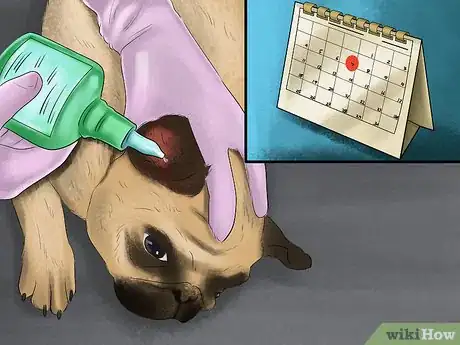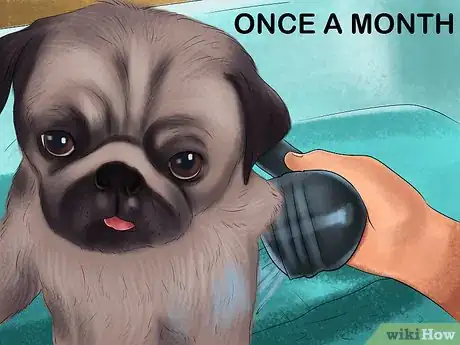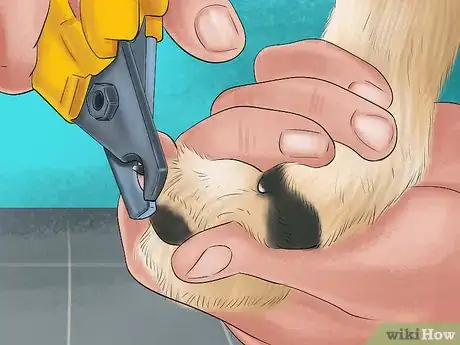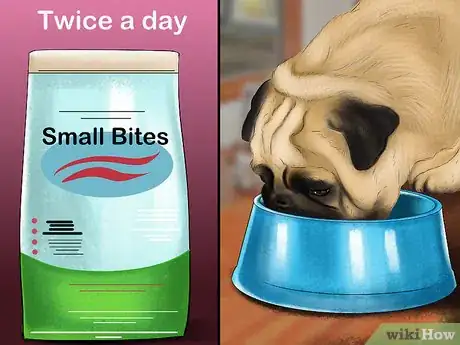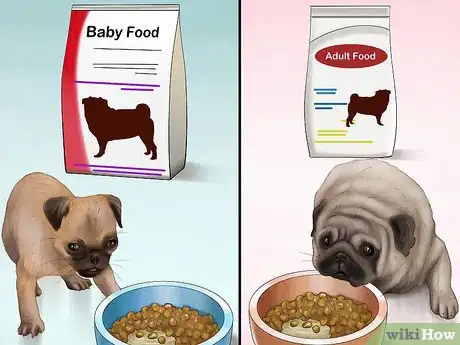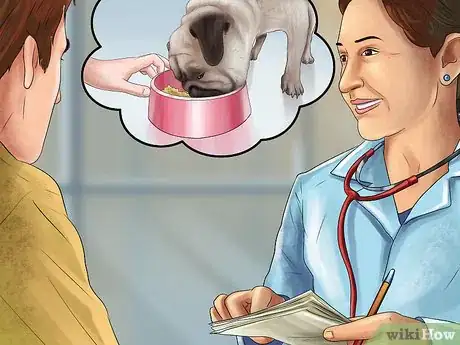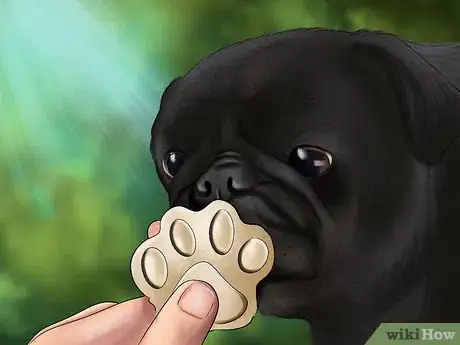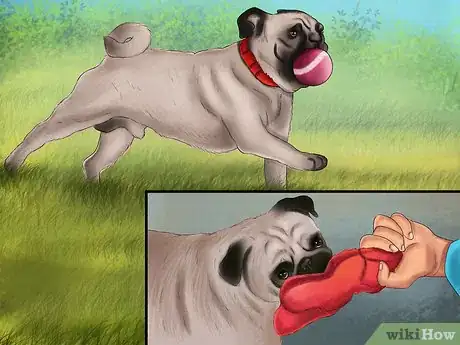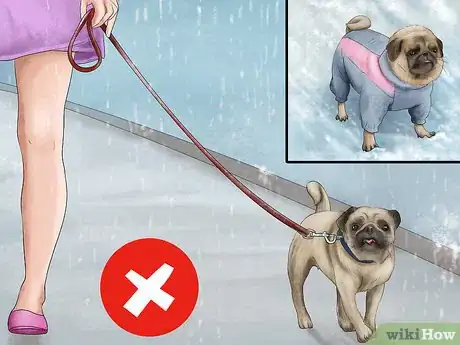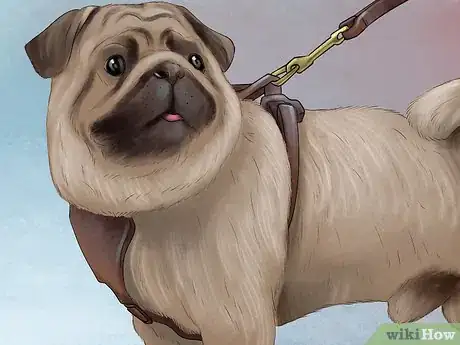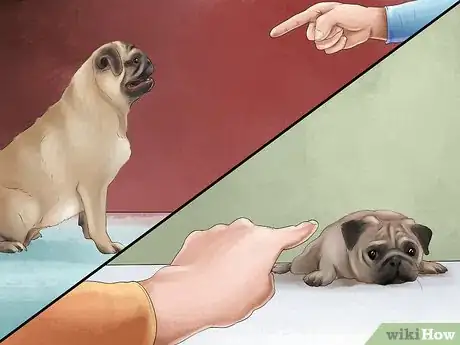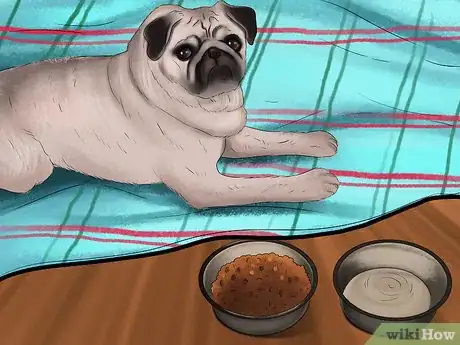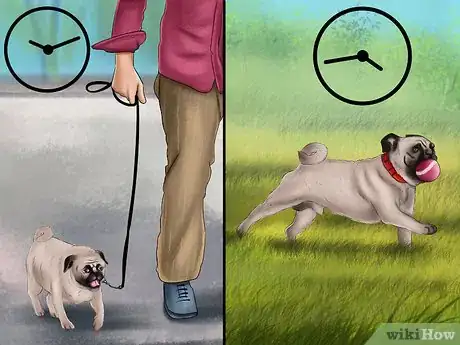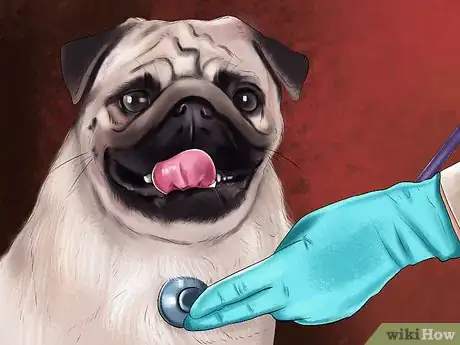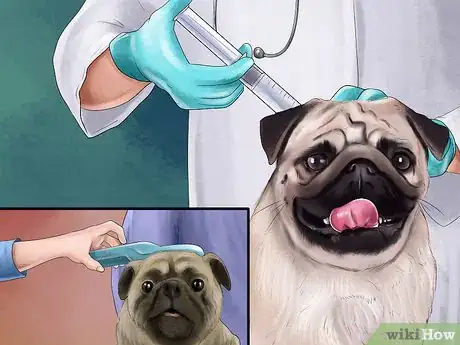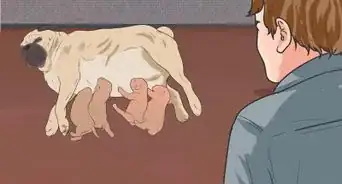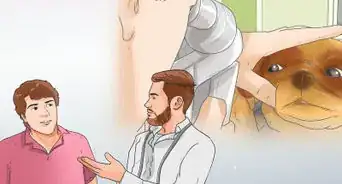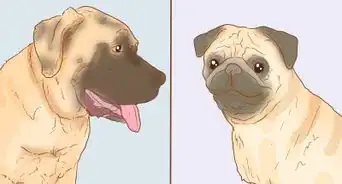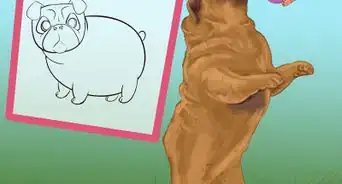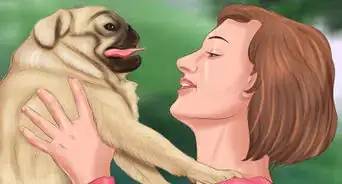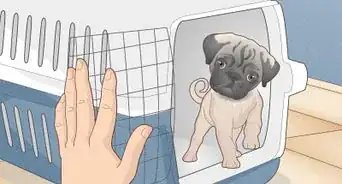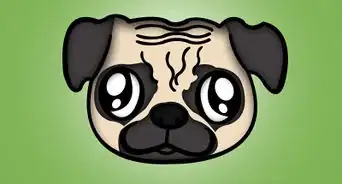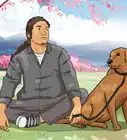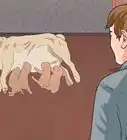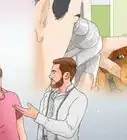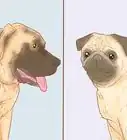This article was co-authored by Pippa Elliott, MRCVS. Dr. Elliott, BVMS, MRCVS is a veterinarian with over 30 years of experience in veterinary surgery and companion animal practice. She graduated from the University of Glasgow in 1987 with a degree in veterinary medicine and surgery. She has worked at the same animal clinic in her hometown for over 20 years.
There are 10 references cited in this article, which can be found at the bottom of the page.
wikiHow marks an article as reader-approved once it receives enough positive feedback. This article received 17 testimonials and 89% of readers who voted found it helpful, earning it our reader-approved status.
This article has been viewed 151,539 times.
Pugs are a friendly and affectionate dog breed that love attention almost as much as people love their folded-up faces. These dogs need special care, though, to keep them happy and healthy. Create a consistent routine of meals, play time, and quiet time for your pug, and make sure you provide them with regular cleanings, nail trims, and baths. It can take a little extra work, but with some attention you can care for all of your pug’s unique needs.
Steps
Grooming a Pug
-
1Give their facial folds a weekly clean. Your pug’s facial folds can hold onto food, saliva, dirt, and other debris that may be smelly and irritating. Use a cotton swab dipped in warm water to clean them out. Run the swab along the folds around your dog’s nose and eyes, being careful to not let the swab make contact with their eyes, nostrils, or mouth.[1]
- Don’t leave the folds damp, as this could cause further irritation. Dry them with a towel or a dry cotton swab.
- While this is recommended as a once-weekly routine, you can do it as often as necessary if you notice your pug starting to smell.
-
2Brush your pug 1 to 2 times a week. Pugs shed, there is no way to avoid it. You can help keep their coat healthy by brushing them once or twice a week with a slicker brush or a specialty shedding brush.[2]
- Brushing your pug regularly will also help keep their hair off of everything you own.
Advertisement -
3Clean their ears with a specialty solution once a week. Those cute little pug ears are just the right shape to trap dirt and debris. Because of this, they should be cleaned regularly with a cleaning solution meant especially for dog’s ears. Squirt the ears with the solution, then wipe the inside down with a cotton ball.[3]
- Do not push the cotton balls into the ear canal or use cotton swabs, as this could damage the dog's ear.
- In you notice deep wax blockages, talk to your vet.
-
4Bathe your pug once a month. Regardless of whether your pug is dirty or smelly, a once-monthly bath is recommended. Be sure the bath water is shallow enough for your pug to stand. Use a shampoo formulated for dogs, which is available from most local pet stores.[4]
- Make sure to rinse your pug thoroughly after shampooing it. Its folds will hold onto soap, so check carefully to make sure your pug is completely rinsed. Be sure to cover its sensitive eyes while you rinse them, too.
-
5Trim their nails as necessary. Pugs don’t wear down their nails the same way more active dogs do, so regular nail trims are important. You can take your pug to a groomer or your vet for a nail trim. If you decide to trim at home, make sure to use clippers meant for dog nails to avoid cracking and splitting. Always cut below the soft center of the nail, called the quick.
- Injury to the quick can be very painful for your pug. If you cannot see the quick because your pug’s nails are dark or opaque, it is best to have a professional trim your their nails instead.[5]
Feeding a Pug
-
1Feed your pug size-appropriate portions. Pugs love to eat, so it’s easy for them to become overweight. You need to monitor their diet closely to ensure proper portion control. Feed them consistently once or twice a day according to the manufacturer's serving size recommendations.[6]
- Remember that food packaging indicates the maximum your pug should eat for a day. If you feed your pug twice a day, divide the maximum serving in half to get the proper meal size.
- Learn to feel for your pug's ribs. Ideally you should be able to feel the ribs with minimum pressure but not see them. If the ribs are difficult to feel, your pug may be overweight.
-
2Give your pug an age-appropriate diet. Choose a quality small-bite dry food appropriate for your pug’s age. If your pug is a puppy, it should eat puppy food. If it is an adult, it should be given an adult diet. If it is a senior, then you should feed it senior food.
- There are also specialized diets for specific medical issues, such as low protein and phosphorus diets for dogs with kidney disease. Talk to your veterinarian about whether a specialized diet is right for your pug.[7]
-
3Reassess the pug's diet over time. If you follow the manufacturer's portion size suggestions and notice your pug gaining unhealthy weight, talk to your vet. They can help you modify meal sizes or switch to a more appropriate food for your dog.[8]
- The appropriate amount of food your dog should eat depends greatly on its specific body and how much exercise and activity it gets.
-
4Limit treats. Treats can be an important part of training, as well as a way to reward your pug for good behavior. However, you need to remember to factor a pug's treats into their daily food intake. Too many treats could cause unhealthy weight gain, which could cause or exacerbate respiratory and joint problems.
- Stick to small treats with your pug, such as training treats. Treats meant for larger dogs should be broken or cut into small pieces.
- Try to use treats consistently for one or two behaviors, such as after a walk or a bathroom break. Avoid giving your pug extra treats outside of these times so you can limit the dog's calorie intake.
Keeping a Pug Active
-
1Offer your pug several shorts bursts of exercise throughout the day. Pugs are active, but often in short bursts, since their flat noses make it hard for them to cool down when running and playing. Help your pug exercise by offering 1 or 2 moderate walks during the day, along with periods of playtime, such as playing fetch, tug-of-war, or chase in the home or in your yard.[9]
- Ideally, a healthy adult pug should get two 15-20 minute walks a day, along with smaller play times with toys throughout the day. If your pug has health problems, walks may need to be shorter.
-
2Keep your pug out of extreme weather. Pugs do best when kept in moderate temperatures and weather conditions. In warm areas or seasons, adjust your walks so that your pug isn’t out during the hottest part of the day. In cold climates or seasons, consider getting your pug a coat for outside time.
- Avoid walks during very windy or excessively rainy days, as these can cause eye problems.
- Pugs are prone to heat stroke if the weather is hot enough. Be sure to never keep them out in the heat on an especially sunny day and make sure that the pug stays hydrated when you are exercising it.
-
3Use a harness on your pug. Due to their short muzzles, pugs sometimes have a hard time breathing. Avoid relying on a collar while walking your pug, as this could limit its breathing further. Attach their leash to a harness instead.
- Dog harnesses are available at all pet stores and can be purchased online.
-
4Train your pug. Pugs are typically smart little dogs that respond well to basic training. They aim to please, so teaching them basic commands by using treats and positive reinforcement usually works well. Be sure to be consistent with your training schedule, taking time to work with your dog every day. This will make caring for your pug easier in the long run and it will strengthen your relationship with the dog as well.
- Teaching your pug how to sit, stay, lay down, and come can be very useful for day to day interactions with your dog. They can be especially helpful if you are trying to discourage bad behaviors, such as chewing or aggression.
- You may also want to teach it how to play games, such as fetch. If your pug is especially adept at responding to your commands, consider teaching it how to run through a little obstacle course.
-
5Enroll your pug in an obedience class. Regardless of whether you bring home a pug puppy or an older rescue, enrolling it in a training class is an important part of bonding with your dog. This will help both of you learn a shared set of commands and provide a designated time each week for the two of you to bond.
- Pugs, especially young pugs, are energetic and eager to please. Enrolling in training will help them learn how to channel that energy into constructive behaviors and help you learn how to manage destructive tendencies.
Keeping a Pug Comfortable
-
1Create a space especially for your pug in your home. Pugs require attention, but should also have a space of their own in which they feel comfortable when you are not home or are otherwise occupied. Provide your pug with an area of its own including a bed and blankets, some toys, and easy access to food and fresh water.[10]
- Consider putting the space in the corner of a well-used area in your home. This way, even if you cannot pay attention to your pug for a moment, they do not feel alone.
- Remember that pugs are sensitive to very hot temperatures and rapid temperature changes. Avoid setting up their space in areas with continued direct sunlight or near heating and cooling vents.
-
2Be consistent in your daily schedule. Pugs are prone to nervousness and anxiety. You can help them calm down by being consistent in your daily routine. This means scheduling feeding times, walks, play times, and quiet times as close to the same time every day as possible.[11]
- Your personal schedule may change, but it is important to you try to keep your pug’s schedule the same. Ask a friend or neighbor to help you out with feeding and walks on nights you know you’ll be home late.
-
3Get a new pug assessed by a veterinarian. The pug’s distinct physiology makes them susceptible to a number of health problems, including breathing and joint issues. Because of this, it is important to schedule a vet check as soon as you bring your new pug home. [12]
- Your vet will be able to check for common pug health complications and make suggestions for care, such as what to feed your new dog.
-
4Have your pug seen by a veterinarian bi-annually. It is important for your pug to be seen by a veterinarian regularly so that it can get preventative veterinary care. A bi-annual check up will ensure that your dog stays up to date on immunizations, preventative medications, and that any emerging health problems can be dealt with quickly.[13]
- Talk to your veterinarian about an appropriate check-up schedule.
- Younger pugs may need to see the vet more often until they are spayed or neutered and have completed their first course of shots.
- Your vet will help you work out a preventative care schedule for things like annual shots, heartworm treatments, parasite elimination, vaccinations, microchipping, and teeth cleanings, all of which are important parts of keeping your pug healthy.
-
5Communicate with your pug effectively. If you want your pug to be comfortable, you’ll need to learn how it communicates and how to properly respond to it. If you don’t have a lot of experience with dogs, educate yourself on how they communicate so that you can interpret your pug's body language and respond appropriately.
- This is especially important if you have children in the house. Teach your children how to recognize when your dog is anxious or fearful, so that they know when to back off.
- For example, if a guest is petting your pug and its tail is between its legs, it is likely scared and/or uncomfortable. To make your pug comfortable, politely ask your guest to take a couple of steps back, crouch down to the dog’s level, and hold out their hand so that the dog can come to them.
Expert Q&A
Did you know you can get expert answers for this article?
Unlock expert answers by supporting wikiHow
-
QuestionWhat type of solution should be used to clean a pug's ears?
 Pippa Elliott, MRCVSDr. Elliott, BVMS, MRCVS is a veterinarian with over 30 years of experience in veterinary surgery and companion animal practice. She graduated from the University of Glasgow in 1987 with a degree in veterinary medicine and surgery. She has worked at the same animal clinic in her hometown for over 20 years.
Pippa Elliott, MRCVSDr. Elliott, BVMS, MRCVS is a veterinarian with over 30 years of experience in veterinary surgery and companion animal practice. She graduated from the University of Glasgow in 1987 with a degree in veterinary medicine and surgery. She has worked at the same animal clinic in her hometown for over 20 years.
Veterinarian
-
QuestionMy pug's hair is constantly falling out. I've tried lotion, powder, and shampoo, but nothing seems to work. Do you have any ideas?
 Pippa Elliott, MRCVSDr. Elliott, BVMS, MRCVS is a veterinarian with over 30 years of experience in veterinary surgery and companion animal practice. She graduated from the University of Glasgow in 1987 with a degree in veterinary medicine and surgery. She has worked at the same animal clinic in her hometown for over 20 years.
Pippa Elliott, MRCVSDr. Elliott, BVMS, MRCVS is a veterinarian with over 30 years of experience in veterinary surgery and companion animal practice. She graduated from the University of Glasgow in 1987 with a degree in veterinary medicine and surgery. She has worked at the same animal clinic in her hometown for over 20 years.
Veterinarian It's important to get your pet checked by a vet in order to rule out a parasitic infection or a medical condition that could be triggering the infection. If he is itchy and scratches, damaging his skin, he may well have allergies. You could try putting him on a hypoallergenic diet for 8-12 weeks and see if his skin health improves during this time.
It's important to get your pet checked by a vet in order to rule out a parasitic infection or a medical condition that could be triggering the infection. If he is itchy and scratches, damaging his skin, he may well have allergies. You could try putting him on a hypoallergenic diet for 8-12 weeks and see if his skin health improves during this time. -
QuestionHow much should you feed a pug?
 Pippa Elliott, MRCVSDr. Elliott, BVMS, MRCVS is a veterinarian with over 30 years of experience in veterinary surgery and companion animal practice. She graduated from the University of Glasgow in 1987 with a degree in veterinary medicine and surgery. She has worked at the same animal clinic in her hometown for over 20 years.
Pippa Elliott, MRCVSDr. Elliott, BVMS, MRCVS is a veterinarian with over 30 years of experience in veterinary surgery and companion animal practice. She graduated from the University of Glasgow in 1987 with a degree in veterinary medicine and surgery. She has worked at the same animal clinic in her hometown for over 20 years.
Veterinarian
References
- ↑ http://www.pugvillage.com/pug-health/general-pug-care
- ↑ http://www.pugvillage.com/pug-health/general-pug-care
- ↑ http://pugdogclub.org.uk/about-pugs/caring-for-your-pug/grooming/
- ↑ http://dogtime.com/dog-breeds/pug#/slide/1
- ↑ http://pugdogclub.org.uk/about-pugs/caring-for-your-pug/grooming/
- ↑ http://www.petpugdog.com/feeding-a-pug
- ↑ http://www.petmd.com/dog/best-foods-dogs-kidney-disease
- ↑ http://www.petpugdog.com/feeding-a-pug
- ↑ http://pugdogclub.org.uk/about-pugs/caring-for-your-pug/exercise/
About This Article
To care for your pug, feed it age-appropriate, small-bite food once or twice a day, based on the serving size recommendations on the packaging. Make sure you stick to the guidelines and limit treats, since excess weight can cause health problems. Additionally, try to get your pug out for a couple of short walks every day, and engage it in brief but active playtimes throughout the day, as well. Then, brush your pug 1-2 times a week, and clean its ears and facial folds every week. You should also bathe it once a month, and trim its nails when they start to get long. For tips from our Veterinary reviewer on how to create a special space for your pug at home, read on!
